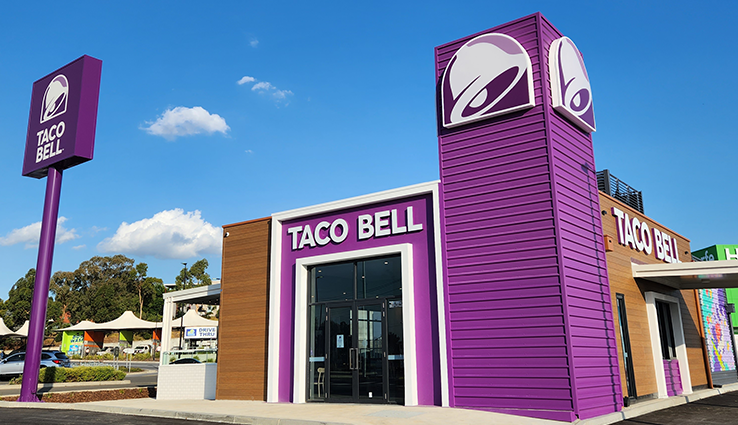Taco Bell, a renowned fast-food chain, has become synonymous with bold and innovative Mexican-inspired cuisine. With its distinctive menu offerings, vibrant branding, and unwavering commitment to delivering a unique dining experience, Taco Bell has carved a special place in the hearts of food enthusiasts around the world. In this article, we will take a closer look at the journey marketing strategies, and key elements that have contributed to Taco Bell’s success.
Taco Bell was founded by Glen Bell in 1962 in Downey, California, with a humble hot dog stand. Drawing inspiration from the traditional flavors of Mexican street food, Glen Bell soon realized the potential of creating a fast-food chain that would bring Mexican-inspired dishes to a wider audience. Taco Bell rapidly expanded, opening its first franchise location in 1964, and it has since grown into a global brand with 8,218 restaurants in 32 different countries worldwide in 2022.
What sets Taco Bell apart is its innovative and eclectic menu, which combines traditional Mexican flavors with a modern twist. From its signature tacos and burritos to creative offerings like the Crunchwrap Supreme and Doritos Locos Tacos, Taco Bell consistently introduces new and exciting menu items. The brand has also embraced vegetarian and plant-based options, catering to the evolving preferences and dietary needs of its customers. This commitment to culinary innovation has helped Taco Bell stay ahead of the curve in the highly competitive fast-food industry.
Taco Bell’s branding strategy is as bold and distinctive as its menu. The vibrant color palette, playful logo, and catchy slogans create an energetic and fun atmosphere that resonates with its target audience. Taco Bell’s advertising campaigns, often featuring humor and pop culture references, further contribute to its youthful and edgy brand image. This branding approach has effectively captured the attention of a diverse customer base, particularly younger generations.
In recent years, Taco Bell has embraced digital innovation to enhance its customer experience. The brand has developed a robust mobile app and online ordering system, allowing customers to conveniently customize their orders, locate nearby restaurants, and earn rewards through the Taco Bell Rewards program. By leveraging technology and engaging with customers through social media platforms, Taco Bell has created a seamless and interactive digital presence, connecting with its audience in meaningful ways.
Taco Bell’s journey from a small hot dog stand to a global fast-food empire is a testament to its culinary innovation, bold branding, and customer-centric approach. With its diverse menu, vibrant branding, embrace of digital technology, and commitment to social responsibility, Taco Bell continues to delight its loyal customers and attract new fans. As Taco Bell continues to evolve and expand, it remains a prominent player in the fast-food industry, satisfying appetites and inspiring cravings with its flavorful and unforgettable dining experience.
Marketing Strategies of Taco Bell
Taco Bell has achieved remarkable success by employing a range of effective marketing strategies. With a focus on innovation, customer engagement, and cultural relevance, Taco Bell has continually captured the attention of its target audience and maintained a competitive edge. Let’s delve into the key marketing strategies that have contributed to Taco Bell’s success, examining how the brand has leveraged its unique approach to drive growth and establish a strong market presence.
Bold Marketing Stunts : Taco Bell is not just known for its mouthwatering menu; it has also gained a reputation for its bold and attention-grabbing marketing stunts. These innovative and daring promotional activities have become a key component of Taco Bell’s marketing strategy, helping the brand stand out in a crowded fast-food industry.
For example, In 2019, Taco Bell took its marketing stunts to another level by launching a pop-up hotel in Palm Springs, California. The “Taco Bell Hotel and Resort” was a temporary immersive experience that allowed fans to stay in a Taco Bell-themed hotel, complete with branded décor, exclusive merchandise, and specially curated menus. This bold marketing move created a frenzy on social media, generating extensive media coverage and attracting Taco Bell enthusiasts from around the world. The Taco Bell Hotel served as a prime example of how the brand’s creative and daring marketing stunts can transform the customer experience and strengthen brand loyalty.

Promotional Swag: Taco Bell has mastered the art of promotional swag, leveraging merchandise and branded items as a key element of its marketing strategy. By offering unique and sought-after products that resonate with its target audience, Taco Bell has successfully transformed its brand into a lifestyle and created a community of passionate fans.
Taco Bell has become synonymous with exclusive merchandise that goes beyond traditional fast-food offerings. The brand collaborates with popular streetwear brands, artists, and influencers to create limited-edition merchandise collections. These partnerships generate excitement and anticipation among fans, as they eagerly await the release of Taco Bell-themed clothing, accessories, and collectibles.
Rebrands: Rebranding is a powerful marketing strategy that enables companies to revitalize their brand image, connect with evolving consumer preferences, and stay relevant in a dynamic marketplace. Taco Bell, known for its innovative approach, has effectively utilized rebranding to maintain its position as a leading fast-food chain.
Taco Bell’s rebrands have played a pivotal role in keeping the brand fresh, relevant, and appealing to a changing consumer landscape. By evolving its brand identity, embracing new product offerings, redefining the dining experience, embracing digital transformation, and fostering emotional connections, Taco Bell has effectively utilized rebrands as a strategic marketing approach. These efforts have enabled Taco Bell to attract new customers, retain a loyal fan base, and maintain its position as a leader in the fast-food industry.
Savvy Social Media: Taco Bell has captured the internet’s attention with their humorous and engaging social media presence. Memorable instances include their personalized outreach to model Chrissy Teigen through a handwritten note, surprising Instagram users with custom rings, and introducing the Taco Emoji Engine—a creative tool that combines a taco with various emojis, photos, or animated GIFs.
Taco Bell’s savvy social media strategy has proven to be instrumental in connecting with its target audience, fostering brand loyalty, and amplifying its brand messaging. By maintaining an authentic brand voice, producing engaging content, embracing trends, launching interactive campaigns, and prioritizing customer service, Taco Bell effectively utilizes social media as a strategic marketing tool. These efforts have solidified Taco Bell’s position as a social media powerhouse and enabled the brand to maintain an active and engaged online community.
Unique Menu: Taco Bell has carved a unique niche for itself in the fast-food industry through its innovative and unconventional menu offerings. The brand’s commitment to culinary experimentation and thinking outside the box has become a core aspect of its marketing strategy.
Taco Bell has consistently pushed the boundaries of traditional fast food by introducing bold and unconventional menu items. The brand’s commitment to culinary innovation has resulted in unique combinations and flavors that set Taco Bell apart from its competitors. From the iconic Doritos Locos Tacos to the Crunchwrap Supreme, Taco Bell’s menu showcases an array of distinctive creations that cater to customers seeking exciting and unconventional food experiences.
Funny Commercials: Taco Bell has built a reputation for its humorous and entertaining commercials, which have become a key element of its marketing strategy. By incorporating humor into their advertisements, Taco Bell effectively captures the attention of viewers, creates memorable brand experiences, and establishes a unique brand identity.
Taco Bell’s success in the fast food industry can be attributed to its innovative approach, targeted advertising, engaging social media presence, brand partnerships, localization efforts, value pricing, and customer-centric focus. By consistently delivering exciting menu items, embracing cultural relevance, and leveraging digital platforms, Taco Bell continues to stay ahead of the competition and attract a loyal customer base. Through its strategic marketing strategies, Taco Bell has successfully positioned itself as a leading player in the fast food industry, driving growth and maintaining its status as a beloved brand among its target audience.
Marketing Mix of Taco Bell
The marketing mix of Taco Bell encompasses a combination of elements that work together to promote the brand, attract customers, and drive sales. These elements, often referred to as the “4Ps” of marketing (product, price, place, and promotion), are strategically managed to create a cohesive and effective marketing strategy. Let’s explore each component of the marketing mix for Taco Bell in detail:
Product:
The product element of Taco Bell’s marketing mix focuses on its menu offerings and the overall customer experience. Taco Bell is known for its Mexican-inspired fast food, featuring items such as tacos, burritos, quesadillas, nachos, and various specialty menu items. The brand continually innovates and introduces new menu items to cater to changing consumer preferences and trends. Taco Bell also offers vegetarian and vegan options to accommodate a wider range of dietary preferences. In addition to the food itself, Taco Bell emphasizes the customization and personalization of orders, allowing customers to tailor their meals to their preferences.
Price:
Pricing is an essential element of Taco Bell’s marketing mix. The brand positions itself as an affordable fast-food option, appealing to price-conscious consumers. Taco Bell offers a range of price points to accommodate different budgets, including value menus, combo meals, and promotional offers. The pricing strategy aims to provide customers with value for their money while maintaining profitability for the brand.
Place:
The place element of Taco Bell’s marketing mix refers to the distribution channels and locations where customers can access its products. Taco Bell operates a network of company-owned and franchised restaurants worldwide. The brand strategically selects locations in areas with high foot traffic, such as shopping malls, busy streets, and entertainment centers. Taco Bell also considers convenience and accessibility, with drive-thru options available in many locations. Furthermore, Taco Bell has expanded its presence through delivery partnerships with third-party delivery services to meet the evolving needs and preferences of customers.
Promotion:
Promotion plays a crucial role in Taco Bell’s marketing mix. The brand employs various strategies to raise awareness, attract customers, and drive sales. Taco Bell’s promotional efforts include advertising campaigns across multiple channels, including television, radio, print media, and digital platforms. The brand often incorporates humor, catchy slogans, and engaging visuals to captivate its target audience. Taco Bell also embraces social media marketing, utilizing platforms like Twitter, Instagram, and TikTok to engage with customers, share engaging content, and run promotional campaigns. The brand frequently collaborates with influencers, engages in brand partnerships, and sponsors events to enhance brand visibility and generate buzz. Additionally, Taco Bell leverages limited-time offers, seasonal promotions, and loyalty programs to incentivize repeat business and drive customer loyalty.
Taco Bell’s marketing mix combines the elements of product, price, place, and promotion to create a compelling and effective marketing strategy. By offering innovative menu items, affordable pricing, convenient locations, and engaging promotions, Taco Bell has successfully positioned itself as a popular fast-food brand. Through its strategic management of the marketing mix, Taco Bell continues to attract and retain customers while maintaining its competitive edge in the industry.
Also Read: Marketing Strategies and Marketing Mix of Starbucks Coffee
To read more content like this, subscribe to our newsletter



